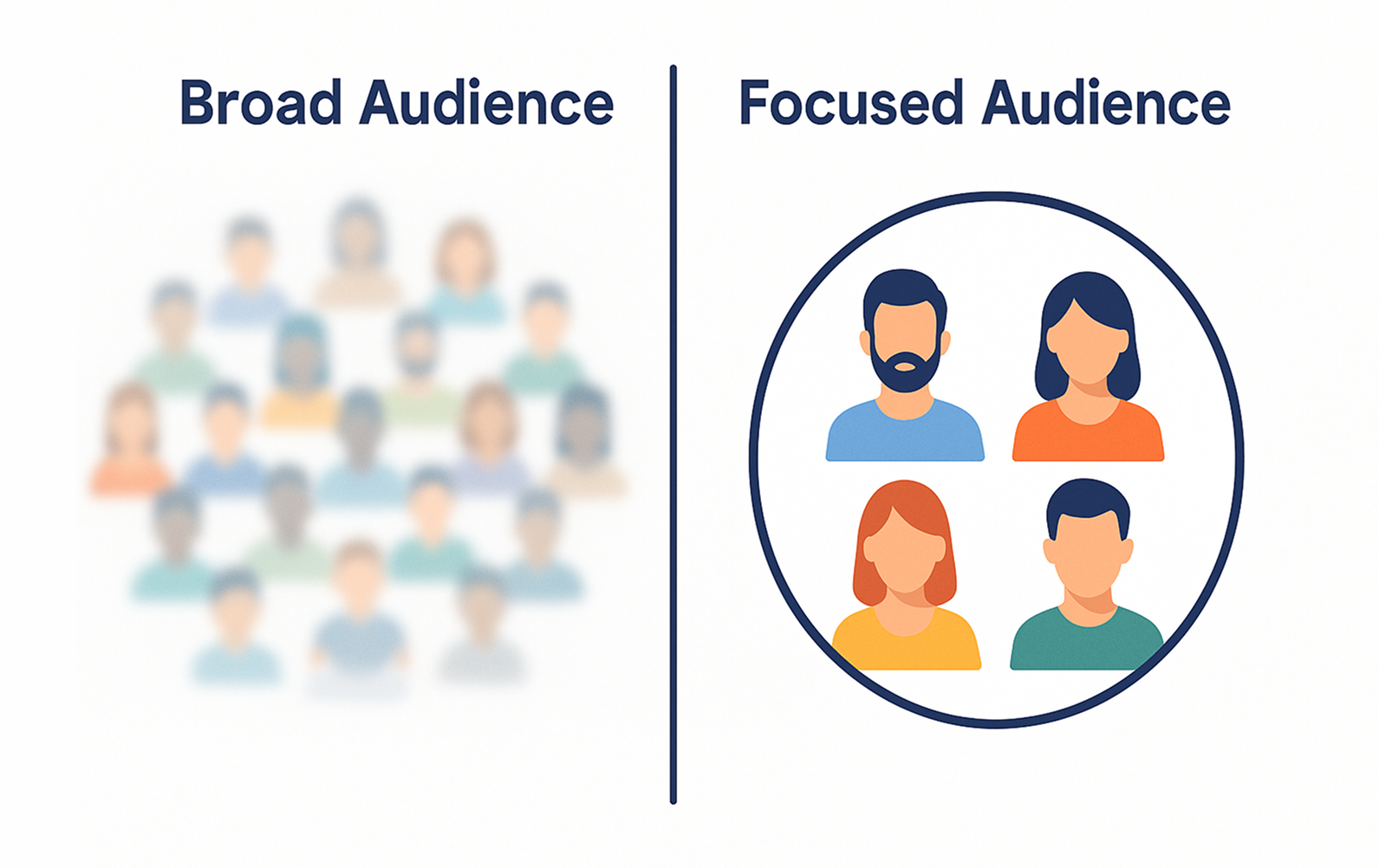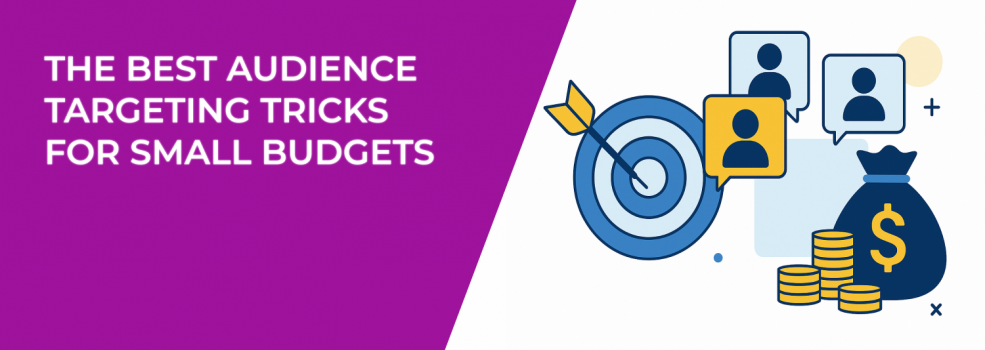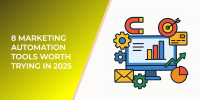Running Facebook or Meta Ads with a small budget can feel like a balancing act — you’re trying to find the right people, deliver meaningful results, and still stretch every dollar.
But here’s the truth: success isn’t about how much you spend, it’s about where and how you spend it. With the right targeting strategies, even a modest daily budget can uncover highly profitable audiences and build sustainable ROI.
1. Start With Smart Audience Definition
The first mistake small advertisers make is skipping the groundwork. Before you even open Ads Manager, get crystal clear on who you’re trying to reach. Think beyond surface-level demographics — what do they value, how do they spend their time, what motivates them to buy?

Creating a persona-driven strategy helps you avoid wasting budget on uninterested users. A great resource to help you do this is How to Define a Target Audience for Marketing: a Step-by-Step Guide.
When defining your target audience:
-
Use behavioral cues, not just demographics. For example, “frequent online shoppers” or “people who engaged with fitness content in the past 30 days” are much stronger indicators than age or location alone.
-
Study your competitors’ followers. Look at their engagement — what type of content drives interaction? You’ll spot audience preferences and messaging clues that can refine your targeting.
-
Map your customer journey. If your audience goes through research-heavy decisions (like services or high-ticket products), focus on awareness and education first, not hard selling.
These steps give you the kind of clarity that turns guesswork into a real strategy. You’ll stop chasing impressions and start understanding what makes your best prospects tick — which means better results for less spend.
Want more tactical examples? Check out Facebook Ad Targeting 101: How to Reach the Right Audience.
2. Use Interest Layering and “Micro” Segmentation
Small budgets require precision. That’s where interest layering comes in — a targeting technique where you stack multiple detailed interests to narrow your audience down to those most likely to buy.
For example:
-
Instead of targeting “Fitness,” try Fitness + Online Shopping + Protein Supplements.
-
Instead of “Business Owners,” use Business Owners + Marketing Software + Paid Advertising.
Each added layer filters out casual browsers and zooms in on people showing consistent intent across interests. This method can significantly improve your click-through and conversion rates.
Once you’ve built these micro-segments, observe their behavior over time. You might discover that your “Fitness + Nutrition” group converts faster than “Fitness + Shopping.” That kind of data lets you double down where performance is strongest.
For more advanced setups, explore How to Layer Detailed Targeting for Hyper-Specific Facebook Audiences.
3. Build Custom and Lookalike Audiences
Small advertisers often think they need massive data to create lookalikes — not true. Even a few hundred high-quality leads or customers can feed Meta’s algorithm with the right signals.
Start simple:
-
Custom audiences from your customer email list or site visitors.
-
Engagement audiences from people who interacted with your content, watched your videos, or messaged your page.
-
Lookalikes based on your top converters, subscribers, or repeat buyers.
Once you’ve set them up, test each one against your cold targeting campaigns. You’ll likely find that lookalike audiences bring in cheaper leads while maintaining higher conversion intent.
If you’re unsure where to start, see Custom vs Lookalike Audiences: What Works Best for Facebook Campaigns.
Pro tip: Create multiple lookalike layers — 1%, 3%, and 5% — and test performance. The 1% audience is your most precise match, while the wider ones help you scale gradually without wasting spend.
When your budget is limited, this balance between precision and reach is everything. You want Meta’s algorithm to have enough data to optimize, but not so much that your ads get diluted.
4. Retarget Smarter — Not Just More Often
When your audience is small, every interaction matters. That’s why engagement-based retargeting is a budget-friendly powerhouse.
Focus on people who:
-
Watched at least 50% of your videos.
-
Clicked your ad but didn’t convert.
-
Engaged with your page or Instagram profile in the last 60 days.
Retargeting works because it speaks to people already familiar with your brand. You don’t need to convince them who you are — only remind them why they were interested in the first place.
For step-by-step implementation, see How to Set Up Facebook Retargeting.
Now here’s where small advertisers go wrong — they over-retarget. If your audience sees the same ad too many times, frequency fatigue sets in fast. Consider alternating between educational, testimonial, and offer-focused creatives to keep retargeting fresh.
You can learn to diagnose this early in Ad Fatigue on Facebook: How to Spot It Early and Fix It Fast.
Fresh retargeting doesn’t just recover lost buyers — it strengthens brand memory. That means next time they see your ad, they’re more likely to click and convert.
5. Let the Learning Phase Work for You
Most small-budget campaigns fail because advertisers panic during the learning phase. Meta’s algorithm needs around 50 conversions per week to optimize delivery. Constant tweaks — changing targeting, pausing ads, or resetting budgets — only prolong that phase.
Give your campaign breathing room for at least 5–7 days. Focus on testing one variable at a time. Want to shorten that learning period? Try these tactics from How to Finish the Facebook Learning Phase Quickly.
Key things to remember:
-
Avoid editing your ad set during learning unless performance is drastically off.
-
Don’t scale too fast. Gradual 10–15% budget increases are safer than doubling your spend overnight.
-
Use consistent optimization events — switching from “Add to Cart” to “Purchase” too early confuses the algorithm.
Following this discipline gives your ads the stability they need to perform consistently. In short — patience pays off, literally.
6. Control Placements and Timing
Automatic placements are fine when you have volume. But small budgets benefit from manual placement control.
For most advertisers, the highest ROI placements are:
-
Facebook Feed and Instagram Feed — high intent and strong visual context.
-
Stories and Reels — perfect for mobile-first audiences and short attention spans.
-
Marketplace — great for product-based offers.
Each placement has its own tone and behavior pattern. For instance, Reels users expect movement and energy, while Feed audiences prefer clear product visuals and social proof.
Combine placement testing with ad scheduling (day-parting). Run ads during high engagement hours — for example, evenings or weekends for e-commerce, work hours for B2B.
You’ll waste less spend and earn more clicks when your ads appear at the right time, in the right place. For more insight, read Why Ad Placement Choices Can Make or Break Your Facebook Campaign.
7. Test Creatives, Not Entire Campaigns
Testing doesn’t have to mean spending more. Instead of splitting budget across multiple campaigns, test creative variations within one audience.
You can rotate elements like:
-
Visuals — compare lifestyle photos vs product-only shots.
-
Hooks — try curiosity-driven headlines against straightforward ones.
-
Formats — switch between single image, carousel, and Reels.
Keeping your targeting stable lets you isolate what truly drives results — the ad’s content itself. Once you identify a winning combination, double down on that creative and gradually test new variants.
Need creative help? Explore The Best AI Text and Image Generators for tools that speed up content production without the cost of a design team.
Remember: creative fatigue happens faster than you think. Refreshing your visuals and copy regularly helps your small budget go further.
8. Segment Budgets by Funnel Stage
When money’s tight, how you allocate your budget can make or break your results. A smart small-budget funnel might look like this:
-
60–70% on your main conversion campaign — one optimized for purchases or leads.
-
20–25% on retargeting — re-engaging people who interacted but didn’t act.
-
10–15% on testing — new audiences or creatives for future scaling.
This structure keeps your main campaign profitable while ensuring your audience stays warm and your learning never stops.
Want to understand how campaign structure affects delivery? Read Meta Ad Campaign Objectives Explained: How to Choose the Right One.
With a small budget, you can’t afford to “set and forget.” Treat your budget like a living system — shifting and adapting as performance data comes in.
9. Watch Metrics That Matter
On a small budget, vanity metrics can be dangerous. Instead of focusing on clicks or likes, prioritize signals that show intent and efficiency:
-
Cost per unique add-to-cart — shows traffic quality.
-
Cost per lead or sale — your real profitability indicator.
-
Frequency and reach ratio — tells you if you’re overexposing your audience.
-
CTR (Link) — anything above 1.2% is usually a good sign your targeting and creative are aligned.
By watching these numbers consistently, you’ll spot performance issues before they spiral. A steady decline in CTR, for example, could mean your creative is fatiguing or your audience is too narrow.
To go deeper, learn how to analyze your ad performance in How to Analyze Facebook Ad Performance Beyond CTR and CPC.
Metrics aren’t just numbers — they’re insights waiting to be used. The best advertisers treat them like a feedback loop, not a scorecard.
10. Keep Learning, Keep Adjusting
Audience behavior shifts fast — especially with privacy updates and algorithm changes. What worked last quarter may not work now. Stay agile. Test monthly. Study insights. Watch for trends.
A helpful read on this evolving landscape is Facebook Ads Targeting Updates: How To Adapt in 2025.
Small advertisers who keep experimenting are the ones who find leverage. You might not have a big budget — but you do have control over your strategy, your creative testing, and your ability to react faster than larger competitors.
Final Thoughts
Small budgets don’t mean small results. They just demand strategic clarity — knowing your audience, keeping your focus narrow, and measuring what truly drives profit. Once you nail targeting, Meta’s algorithm becomes your ally, not your enemy.
In short: smarter targeting beats bigger spending every time.

